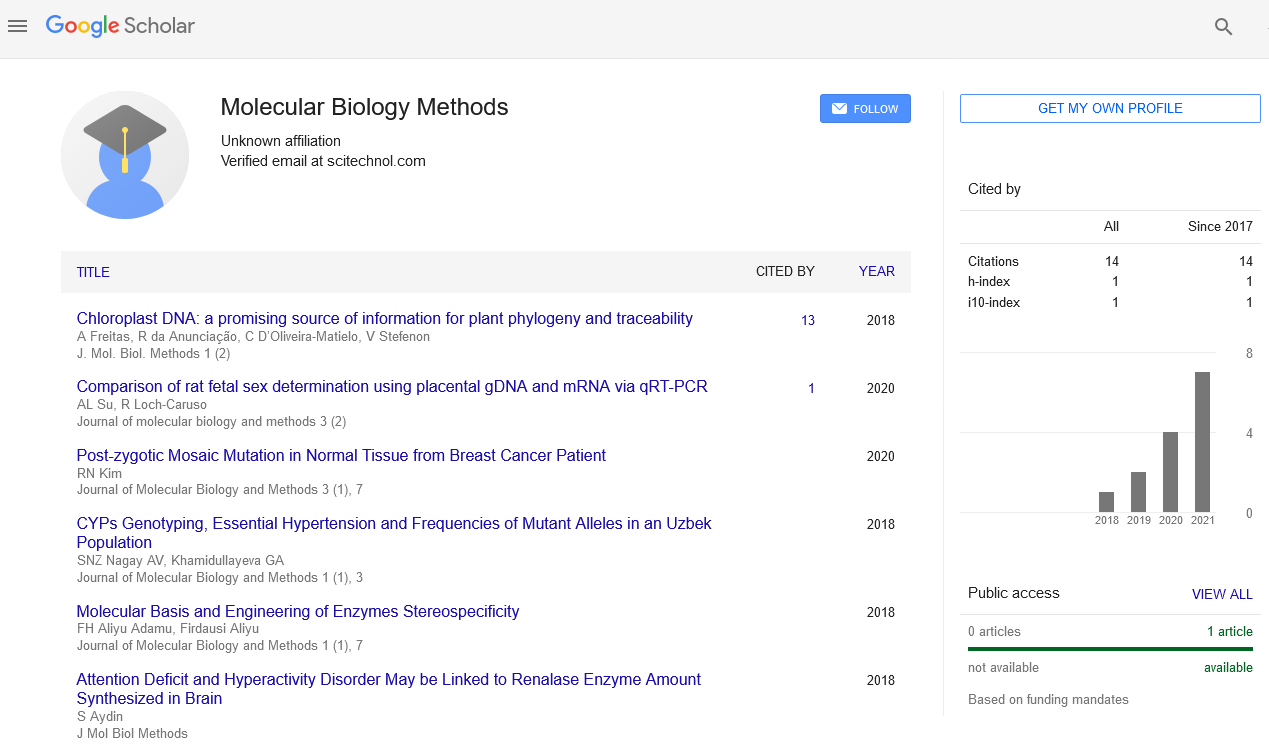Perspective, J Mol Biol Methods Vol: 6 Issue: 1
Separating and Analyzing DNA and Proteins by Using Gel Electrophoresis
Kwang Shin*
1Department of Biology, Dongguk University, Seoul, South Korea
*Corresponding Author:Kwang Shin
Department of Biology, Dongguk University, Seoul, South Korea
E-mail: peterstein@np21.edu
Received date: 20 February, 2023, Manuscript No. JMBM-23-93040;
Editor assigned date: 22 February, 2023, PreQC No. JMBM-23-93040 (PQ);
Reviewed date: 09 March, 2023, QC No. JMBM-23-93040;
Revised date: 16 March, 2023, Manuscript No. JMBM-23-93040(R);
Published date: 23 March, 2023, DOI: 10.4172/JMBM.1000124
Citation: Shin K (2023) Separating and Analyzing DNA and Proteins by Using Gel Electrophoresis. J Mol Biol Methods 6:1.
Description
Gel electrophoresis is a widely used technique in molecular biology that enables the separation of macromolecules, such as DNA and proteins, based on their size and charge. This technique involves the migration of charged macromolecules through a gel matrix under the influence of an electric field. The separated molecules can be visualized and analyzed to gain insights into their structure, function, and interactions. The basic principle of gel electrophoresis is to apply an electric field to a gel matrix that contains biomolecules to be separated. The gel matrix is usually made of polyacrylamide or agarose, which are porous materials that allow the biomolecules to move through the gel. When an electric field is applied, the biomolecules move towards the oppositely charged electrode. The speed and direction of the movement depend on the size, charge, and shape of the biomolecules. Smaller and more negatively charged molecules move faster and migrate further in the gel matrix than larger and less negatively charged molecules. The methodology of gel electrophoresis involves several steps, including sample preparation, gel preparation, loading of the sample onto the gel, electrophoresis, staining, and visualisation. Sample preparation involves the isolation of DNA or proteins from the source material and the addition of a loading buffer that contains a tracking dye and a reducing agent to denature the sample and disrupt any disulfide bonds. The sample is then loaded onto the gel, which is typically made in a horizontal or vertical format, and is subjected to an electric field that causes the molecules to migrate through the gel matrix. The migration rate of the molecules is determined by their size, charge, and shape. After electrophoresis, the gel is stained with a dye, such as ethidium bromide or Coomassie blue, that binds to the DNA or protein, respectively. The stained gel is then visualised using UV light or a protein imager. Gel electrophoresis can be performed using different techniques, depending on the type of biomolecule to be separated and analysed. For DNA and RNA, agarose gel electrophoresis is the most commonly used technique. The gel matrix is made of agarose, which is a polysaccharide extracted from seaweed. The agarose gel is poured into a mould, and wells are created for loading the DNA or RNA samples. The gel is then submerged in a buffer solution, and an electric field is applied. The DNA or RNA fragments migrate through the gel matrix, and their size is visualised by staining the gel with ethidium bromide, which fluoresces under UV light.
Gel electrophoresis has numerous applications in molecular biology, including DNA fingerprinting, gene mapping, and protein analysis. DNA fingerprinting involves the comparison of DNA fragments from different individuals to identify unique patterns that can be used for forensic and paternity testing. Gene mapping involves the separation and analysis of DNA fragments to determine their position on a chromosome and their relationship to other genes. Protein analysis involves the separation and quantification of proteins to study their structure, function, and interactions.
Conclusion
Gel electrophoresis is a powerful technique for separating and analysing DNA and proteins. This technique has revolutionised molecular biology and enabled the development of new diagnostic and therapeutic approaches for human diseases. Gel electrophoresis will play an important role in understanding the structure and function of biological molecules. The methodology of gel electrophoresis is relatively simple and can be easily adapted for various applications.
 Spanish
Spanish  Chinese
Chinese  Russian
Russian  German
German  French
French  Japanese
Japanese  Portuguese
Portuguese  Hindi
Hindi 